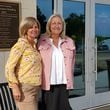A study in location
Fletcher Crowe and Anita Spring say Fort Caroline was not on the St. Johns River near Jacksonville, as history states. The error can be traced to inaccurate translations and faulty documents, they say. They base their conclusions on seven criteria.
• Analysis of French maps
• Analysis of Spanish maps
• Analysis of English maps
• Review of the area’s network of rivers
• The latitude of Fort Caroline
• Analysis of Native-American linguistics
• Geophysical features of the region
Help had come just in time. Jean Ribault brought provisions from the motherland; the settlers living in and around the fort must have been relieved to know that France had not forgotten its countrymen in the vast, dangerous New World.
None knew the danger better than Ribault. After making sure the fort’s occupants were safe, he set sail with four ships loaded with soldiers. He would strike the Spanish before they attacked the French.
It was the wrong decision. A tropical storm swept the coastal forests and scrub land. Ribault’s ships foundered. The Spanish, meantime, marched overland from St. Augustine, through the storm. They attacked in the dark. Few survived.
The Spanish would take over the fort and rename it before eventually abandoning the structure. And history would record that Fort Caroline, the first attempt by the French to settle in the New World, would vanish somewhere near present-day Jacksonville, Fla.
Or did it?
Two retired professors believe history could be wrong. Fort Caroline, they say, may have been in coastal Georgia on the Altamaha River. They’ve located spots, they say, that could prove Georgia, not Florida, was where France made a short-lived stand in North America.
For more than two years, Fletcher Crowe and Anita Spring have been tracking down ancient maps, poring over 500-year-old narratives and reviewing modern records in the search for the remains of Fort Caroline. French settlers, Huguenots, built the fort in 1564. Their massacre at the hands of Spanish soldiers, 15 months later, effectively ended French attempts to colonize a swath of the New World.
For more than a century, historians have assumed the fort was on the St. Johns River near Jacksonville. A federal park, with a recreation of the fort, marks a spot where they think the French made their ill-fated attempt at colonization.
“We’ve come to the conclusion,” Crowe said, “that it is a bunch of baloney.”
Spring was more diplomatic, but just as emphatic. “School children are learning history, etc., etc.,” she said. “It’s just incorrect.”
Not everyone agrees with the two. Others are searching for Fort Caroline along the St. Marys River, on the Georgia-Florida line. And still others insist that history has the location right. One archaeologist suggested that Crowe’s and Spring’s research has inadvertently touched off a “Georgia vs. Florida rivalry.”
And it all began with a trip to a bookstore.
Ancient language, modern research
Crowe, who taught history at Florida Atlantic University and Bethune-Cookman University in Daytona Beach, took a trip to St. Augustine. Spring, professor emeritus of the Department of Anthropology at the University of Florida, went with him. Their travels took them downtown, where the two stepped into a shop specializing in old books. Crowe spied a volume written by Ribault, the fellow who’d returned to Fort Caroline, only to set sail against the Spanish in a doomed effort at proactive warfare.
The book detailed the early days of French expansion into the New World. The fact that it was written in archaic French didn’t daunt Crowe; he knows the language.
He was intrigued, but eventually returned the book to the shelf. Spring returned, purchased the narrative, and gave it to her friend. As he turned the pages, Crowe began to think historians needed to take another look at the Fort Caroline story.
From that point, “I was hooked,” Crowe said.
A hook that has lured him to archives at the University of Florida in Gainesville; to record rooms at the University of Georgia; to extensive documents at the Newberry Museum in Chicago; and, at last, to a sort of academic ground zero: Bibliothèque nationale de France, France’s national library. His knowledge of old French, he said, was invaluable in his research.
“Some translations” of maps and narratives, he said, “are indisputably wrong.”
For example one report used a word that, if incorrectly translated, means “below” instead of “above.” “If you’re talking about whether a fort is above or below a river … that is important.”
Some French documents hint that the fort’s location is not on the St. Johns, he said. And at least one ancient report offers map coordinates that indicate the fort’s location is in southeast Georgia, not northeast Florida.
Crowe also points to a bit of espionage he uncovered in his research. In the early 1560s, a Spanish spy stole a French map of the Fort Caroline region. A translation of the purloined document described a river unlike the St. Johns, Crowe said.
While Crowe pored over ancient French texts, Spring put her training of Native-American culture and anthropology to work. She began comparing native words that French visitors had included in their narratives. Some, credited to the Timucan people who lived on the coast of Florida 500 years ago, were actually from Muscogee — a culture that flourished among people who lived north of Florida in what today is coastal Georgia.
The two educators have compiled 38 “site requirements” that a tract would have to meet to qualify as Fort Caroline.
“Based on that,” she said, “we determined that the fort was not on the St. Johns River.” Sites on the Altamaha and St. Marys rivers score far higher, Spring said.
They believe Fort Caroline was about 80 miles north of Jacksonville. Neither is saying exactly where; they have nondisclosure agreements with private landowners.
‘Don’t see it’
Crowe and Spring offer a “provocative idea,” said Robert Thunen, an associate professor of sociology, anthropology and social work at the University of North Florida. But a French fort “just doesn’t show up in the Georgia archaeological record. I’m sorry. I just don’t see it.”
The retired educators’ research assumes that St. Augustine — the original St. Augustine, which was not where the city is today — was miles away from its present site. In fact, said Thunen, St. Augustine did move, but only a mile or so from its original location. Spanish forces intent on murdering the French launched their march from St. Augustine; they could not have reached a fort on the St. Marys or Altamaha rivers in such a short period, Thunen said.
He’s also a “little suspicious” about the maps Crowe and Spring have cited in their research; they’re old documents, Thunen said, and possibly flawed.
He’s waiting to see some proof — an artifact, for example that proves the French presence on the banks of a Georgia river.
He also readily admitted that he has no proof that Fort Caroline was ever anywhere near Jacksonville. In 2012, he conducted surveys around the suspected location for Fort Caroline. "We came up with nothing," he said. "We know where the fort's not."
He believes that diligent digging, the figurative and literal variety, is the only way to settle the dispute.
“In some ways,” he said, “this is turning into a Florida-Georgia rivalry.”
Florida native Charles Meide, another scientist who has studied Fort Caroline, shares Thunen’s skepticism. He’s director of the Lighthouse Archaeological Maritime Program at the St. Augustine Lighthouse & Museum, and has long been fascinated with the lost fort.
Spanish accounts of the attack, Meide said, make no mention of crossing a big river. To reach a fort in present-day coastal Georgia, he said, the forces would have had to cross the St. Johns — no mere creek.
For Meide, the question of the fort’s location hits close to home. When he was a boy, the Jacksonville native rode a school bus to the Fort Caroline site. He was transfixed by what teachers told him happened in his figurative backyard.
“I remember drawing pictures of little French guys fighting little Spanish guys.”
He still believes what teachers told him all those years ago. “I don’t have any reason to doubt what historians and archaeologists have said for decades,” he said. “The evidence I’ve see confirms all the stories I heard as a kid.”
Despite the criticism, Crowe and Spring are going forward with their work. They've formed an association, the Fort Caroline Archaeology Project, which has dispatched research teams into the forests of southeast Georgia. Those forays have cost about $20,000. They're seeking money to fund another excursion.
If they get the cash, and landowners agree to a detailed search, Crowe said, “we’ll be on that property like fleas on a dog’s back.”
They also don’t expect people to accept their hypothesis until they have real proof that French settlers lived, briefly, along a river in Georgia’s lowlands. Research is best tested by rigorous study and tough questions — something they think is lacking in the current accepted theory.
“That,” said Crowe, “is inexcusably bad scholarship.”
About the Author

/cloudfront-us-east-1.images.arcpublishing.com/ajc/P7DYBH6TO7FEKG4SUXQQKADRXE.jpg)



